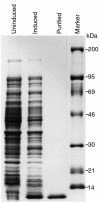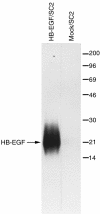Heparin-binding EGF-like growth factor contributes to reduced glomerular filtration rate during glomerulonephritis in rats
- PMID: 10675360
- PMCID: PMC377436
- DOI: 10.1172/JCI2869
Heparin-binding EGF-like growth factor contributes to reduced glomerular filtration rate during glomerulonephritis in rats
Abstract
Heparin-binding epidermal growth factor-like growth factor (HB-EGF), a member of the epidermal growth factor (EGF) family, is expressed during inflammatory and pathological conditions. We have cloned the rat HB-EGF and followed the expression of HB-EGF in rat kidneys treated with anti- glomerular basement membrane (anti-GBM) antibody (Ab) to induce glomerulonephritis (GN). We observed glomerular HB-EGF mRNA and protein within 30 minutes of Ab administration and showed by in situ hybridization that glomerular HB-EGF mRNA expression was predominantly in mesangial and epithelial cells. Expression of HB-EGF correlated with the onset of decreased renal function in this model. To test the direct effect of HB-EGF on renal function, we infused the renal cortex with active rHB-EGF, prepared from transfected Drosophila melanogaster cells. This treatment induced a significant decrease in single nephron GFR (SNGFR), single nephron plasma flow, and glomerular ultrafiltration coefficient and an increase in the glomerular capillary hydrostatic pressure gradient. In addition, anti-HB-EGF Ab administered just before anti-GBM Ab blocked the fall in SNGFR and GFR at 90 minutes without any change in the glomerular histologic response. These studies suggest that HB-EGF expressed early in the anti-GBM Ab GN model contributes to the observed acute glomerular hemodynamic alterations.
Figures







References
-
- Wilson, C.B. 1996. The renal response to immunological injury. In Brenner and Rector’s the kidney. 5th edition. B.M. Brenner, editor. W.B. Saunders Co., Philadelphia, PA. 1253–1391.
-
- Harris RC. Growth factors and cytokines in acute renal failure. Adv Ren Replace Ther. 1997;4:43–53. - PubMed
-
- Feng L, Tang WW, Loskutoff DJ, Wilson CB. Dysfunction of glomerular fibrinolysis in experimental anti-glomerular basement membrane antibody glomerulonephritis. J Am Soc Nephrol. 1993;3:1753–1764. - PubMed
-
- Garcia GE, et al. Expression of heparin-binding EGF (HB-EGF) in glomerulonephritis (GN). Recombinant (r) HB-EGF decreased glomerular filtration rate (GRF) J Am Soc Nephrol. 1994;5:692. (Abstr.)
Publication types
MeSH terms
Substances
Grants and funding
LinkOut - more resources
Full Text Sources
Other Literature Sources

